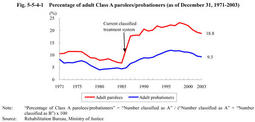| Previous Next Index Image Index Year Selection | |
|
|
1. Enhancement of classified or categorized treatment (1) Principle of individualization Probation/parole supervision must be carried out in such a way that suits a probationer/parolee best in consideration of his/her age,career,physical and mental condition,family,friends,and other circumstances(Article2of the Offenders Rehabilitation Law,Article2of the Law for Probationary Supervision of Persons under Suspension of Execution of Sentence).This principle is called individualized treatment.In practice,two approaches have been taken for putting this principle into action:(1)greater direct involvement of probation officers and(2)diversification of treatment.The first approach is taken in classified treatment,while the second approach is taken in categorized treatment as well as in intermediate treatment to those parolees serving long-term sentences as described in this chapter,Section2,4 .
(2) Classified treatment Classified treatment was introduced in1971.It is a system to classify parolees/probationers into Class A or B according to the expected level of difficulty in treating them.Those who seem difficult to treat are put into Class A,while others are placed in Class B.The system requires probation officers to change the extent of their direct involvement in supervising activities according to the cases.For a Class A parolee/probationer,the probation officer in charge is required to communicate and consult with the volunteer probation officer frequently and to make well-planned and intensive meetings with the parolee/probationer,his/her family,employer,and other related persons and to communicate with relevant organizations according to a preset schedule throughout the supervision period.For a Class B parolee/probationer,the probation officer is required to be directly involved with the case only if it becomes clear that the offender has problems and needs special care,or if the pro bation officer determines based on a volunteer probation officer's report that direct involvement is necessary.The classified treatment system is designed to increase direct involvement of probation officers for Class A cases,maintaining the cooperation with volunteer probation officers.
Classification as A or B is made in a comprehensive manner based on the calculation of points allocated to the specified items and also on probation officers'clinical assessment.After its introduction in1971the classified treatment system was once revised in1986,and almost20years have passed since then.The Rehabilitation Bureau is currently in the process of reviewing the system again. Fig. 5-5-4-1 shows the percentage of Class A parolees and probationers since the introduction of the classified treatment system in1971. Fig. 5-5-4-1 Percentage of adult Class A parolees/probationers(as of December31,1971-2003) (3) Categorized treatment Categorized treatment is a system designed to make supervision more effective by categorizing parolees/probationers according to their nature of problem and type of offense/delinquency,and by providing treatment standardized for each category.Since the introduction in1990the categorized treatment system has become indispensable treatment measures together with classified treatment system.
During the recent10-year period,the types of parolees/probationers as well as crime situations have changed,and more effective treatment methods have been developed.In response to them,the Rehabilitation Bureau of the Ministry of Justice increased the number of categories to meet the diversified treatment needs and completely revised the treatment guidelines in April2003to make the categorized treatment system more effective with the help of the latest findings. The revision changed the category of"unemployed juveniles"to"unemployed offenders"and added three new categories-"alcoholics,""elderly,"and"addicts to gambling or other undesirable conduct"-to the existing nine categories of"thinners and other substances abusers,""stimulant drug offenders,""organized crime group members,""bosozoku(motorcycle gang)members,""sex offenders,""mentally or otherwise disabled","junior high school students,""school violence offenders"and"family violence offenders."The category of"family violence offenders,"which once focused on the violence inflicted by juveniles on their parents,has been expanded to cover all types of family violence including child abuse and domestic violence(DV)on spouses.Furthermore,the new guidelines contain specific and detailed information about each category such as the characte ristics and problems common among the offenders of the same category,examples of special supervision conditions and instructions,and detailed treatment methods,and also a list of related organizations and social resources helpful in treating parolees/probationers in that category.The new guidelines are designed to improve the knowledge of probation officers and volunteer probation officers and to make them share the same goal in the course of supervision. The next necessary step will be to make appropriate and effective implementation of the revised categorized treatment system to further enhance probation/parole supervision. |
